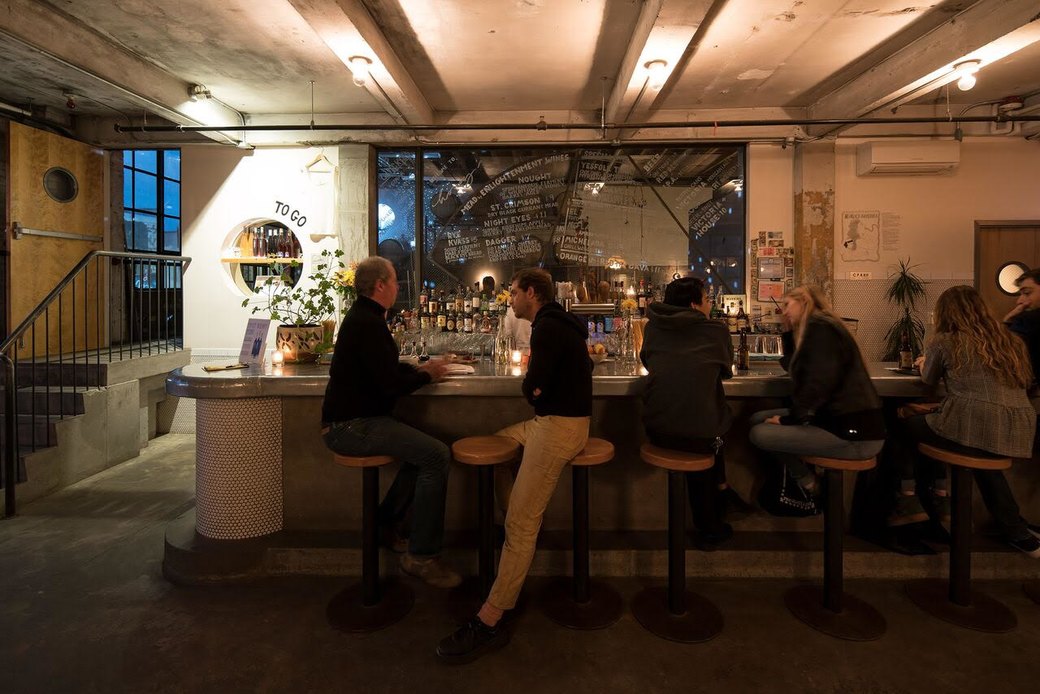
Nestled in the corner of an industrial Bushwick neighborhood is Honey’s, a tasting room attached to New York City’s first meadery. Those who pass it on the street might think it’s just another hidden cocktail bar off the Jefferson L subway stop — and they’re not totally wrong. Honey’s is a cocktail bar, but all of the mead it sells is made directly next door at Enlightenment Wines Meadery.
“It’s kind of like we’re a pasta factory with a restaurant in the front,” co-owner and mazer (a mead-maker), Raphael Lyon said. Honey’s is a tasting room where customers can sip on mead that’s made inside the attached meadery. If visitors would rather have a cocktail or a beer, that’s fine, too, the bar is fully equipped.
When I arrived at Honey’s, Lyon,who co-owns Enlightenment Wines Meadery with Arley Marks and Tony Rock, walked me through the tasting room and directly into the attached meadery. The open space had a rustic feel and held various wooden barrels stacked against its back wall.

It was lit by a glistening disco ball that gave the meadery a groovy feel, almost so much that I forgot mead was being fermented directly beneath it. We kept walking, and Lyon brought me to a handful of barrels where mead was aging. He propped himself up, opened one of the barrels, and started stirring the mead that’d soon be sold in the tasting room next door.
I couldn’t help but wonder what the difference was between making mead and fermenting wine. “It’s natural winemaking that starts with honey rather than grapes,” he explained. “What we’re trying to do at Enlightenment Wines Meadery is make mead the way that mead’s been made for 10,000 years. Essentially, we’re making wine. We’re doing everything a grape winer maker would make—except we’re starting with honey and water instead of grape juice.”
That’s exactly what mead is: honey-wine. However, honey isn’t the only ingredient that’s involved with mead making. Many meads are fermented with herbs, flowers, and fruits. What makes Lyon’s mead so special is that he’s often found foraging some of the ingredients himself in New York State, while other ingredients are sourced from natural farmers.

After sitting down at the cozy cocktail bar at Honey’s and trying a majority of the mead, I could automatically taste (and smell) the drink’s floral and fruity assets. Night Eyes, which is a sparkling mead made with cherry, apple, cranberry, sumac and rosehips, was by far the fruitiest mead that I tried at Honey’s. However, it definitely wasn’t sweet. In fact, none of the mead options at Honey’s are considered “sweet,” and Lyon wants you to know that.
“I think one of the most important things for people to know about our mead is that it’s not sweet. We make dry mead, and a lot of people expect it to be sweet because it’s made from honey, but what they don’t understand usually is that all alcohol starts out sweet,” Lyon said.
If that seems like something you want to try, drop by for a glass (don’t worry, the bartender will give you tastes of various meads so you can pick your favorite one). After Night Eyes, my second favorite was the Nought, which features fermented wildflower honey and well-water aged in red wine barrels.

A close third in my book would be the Floralia, which is a botanical mead infused with lavender, juniper and marjoram.
While you’re sitting at the bar, there’s one thing that you should keep in mind: Honey’s mead has an ABV of about 12 percent, according to Lyon. He says that his mead has a “light” and “positive” affect, however, the company’s website encourages guests to try the mead for themselves to see how they feel.
If you end up getting hungry after your boozy outing to Honey’s, fear not. Lyons said the company does have a kitchen, and serves food on Monday, Tuesday and Wednesday. Apparently, the menu is mostly (but not completely) vegetarian and features a lot of ramen.

Now, I know what you might be thinking: why Bushwick? Apparently, it was the perfect spot for Enlightenment Wines Meadery’s expansion, “Bushwick was a really good place for us because it’s got two things that are really hard to find in the rest of the city: It’s got properly zoned manufacturing space, which is what we need for a production facility, but it’s also close enough to residential areas where people can come here and get a drink.”
If you end up swinging by Honey’s for a drink and loving it, I have good news: Thanks to the company’s farm winery license (and the fact that all of their mead’s ingredients are sourced in New York), it can sell mead bottles on site. In other words, you can choose from a selection of seasonal meads and bring a bottle home with you.
After you take home your bottle of mead, you might want to stay up to date on Honey’s happenings. Lyon suggests following Enlightenment Wines Meadery on Instagram, or following the events listed on the company’s Facebook page. Cheers!
Cover photo image courtesy of Honey’s.


